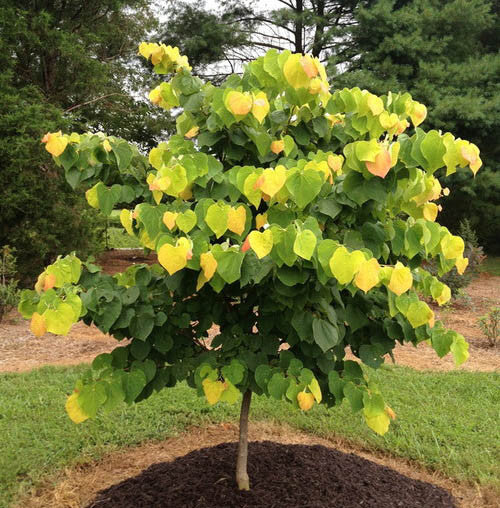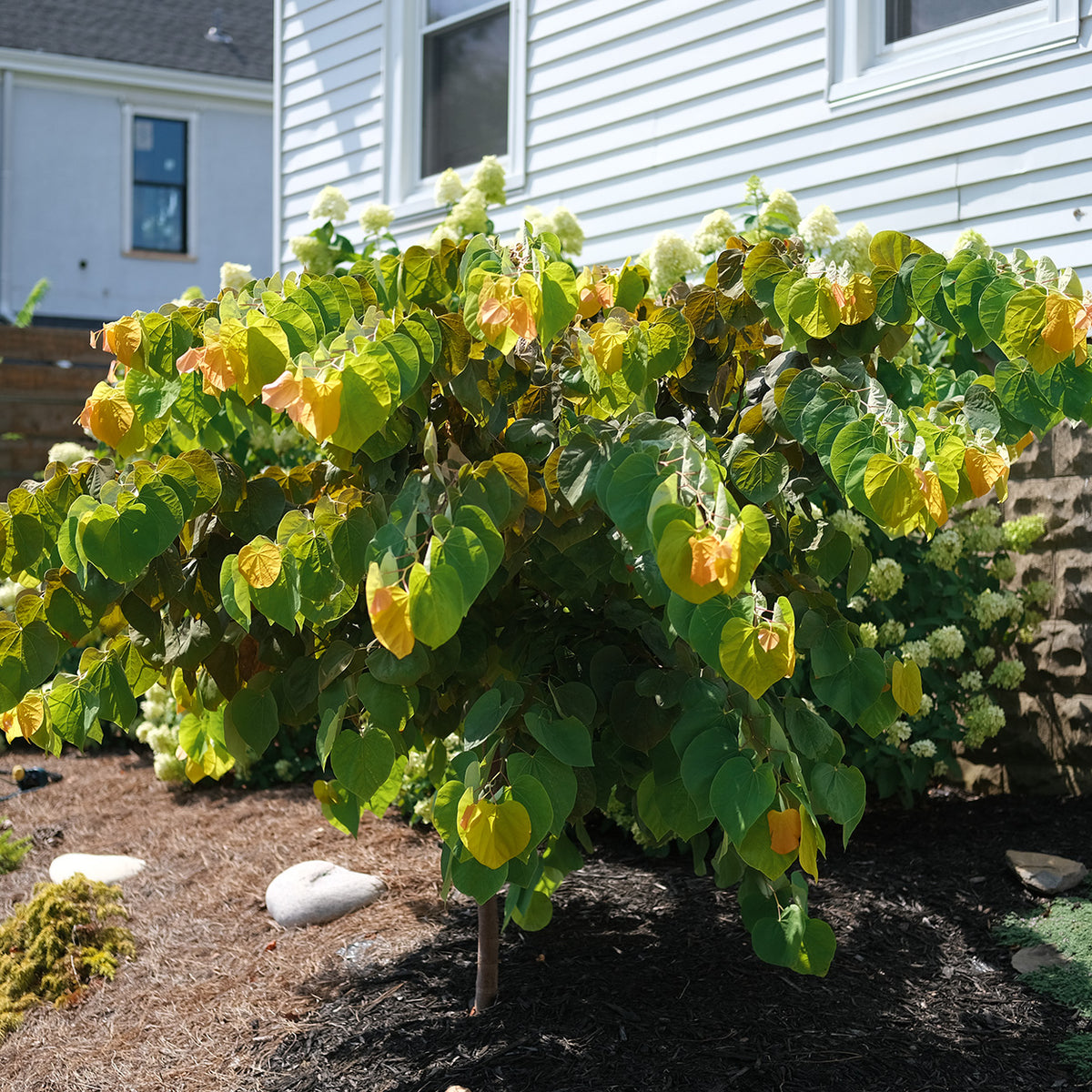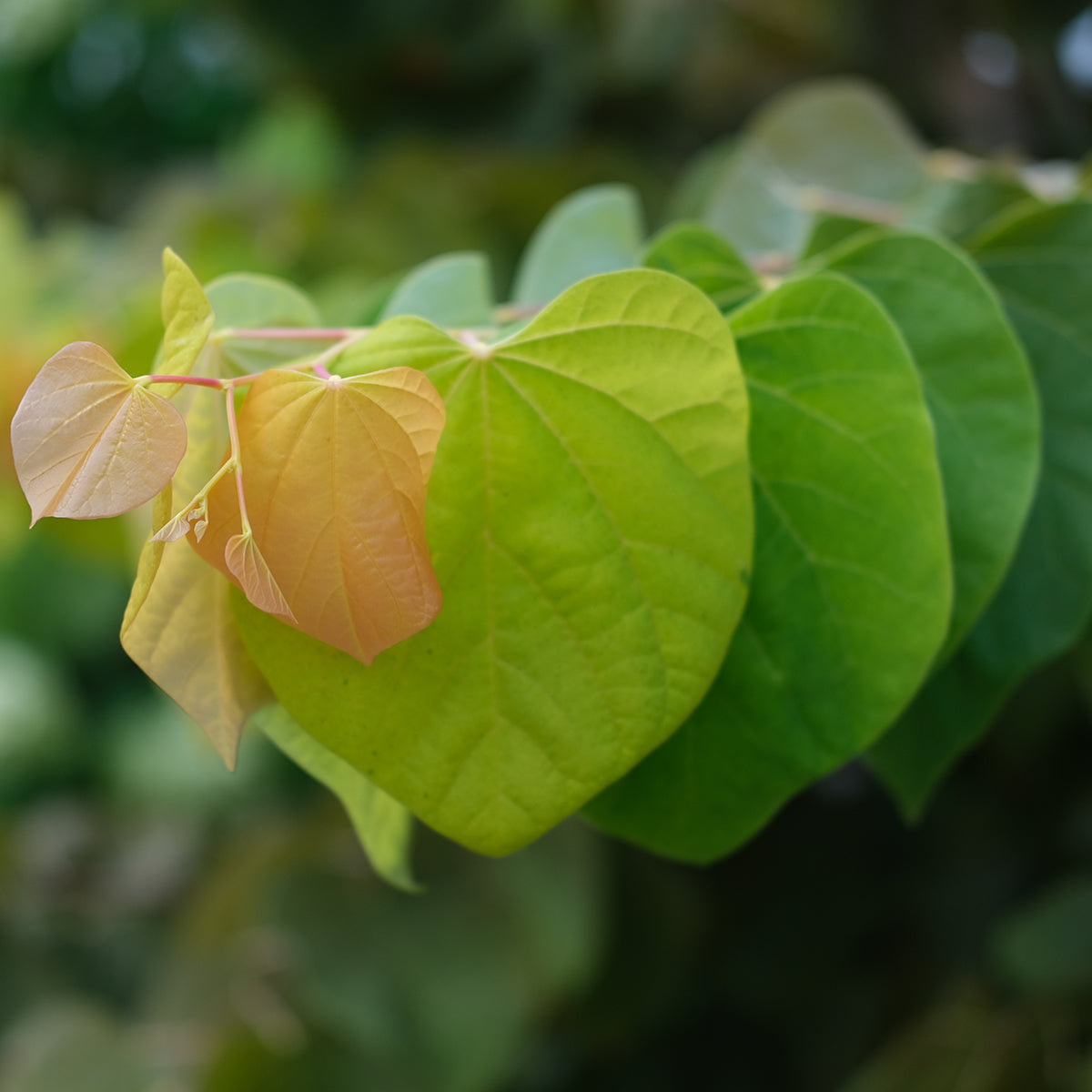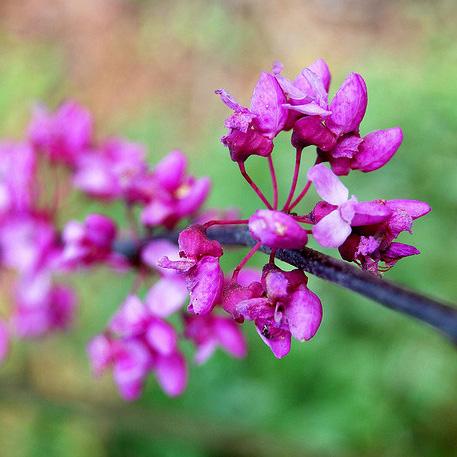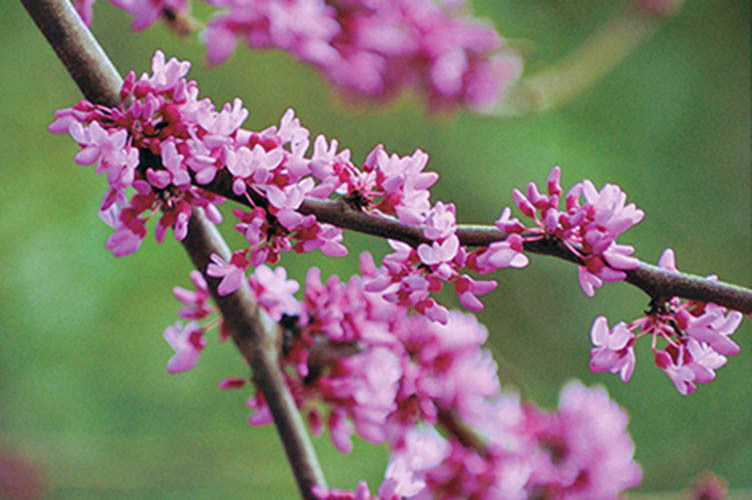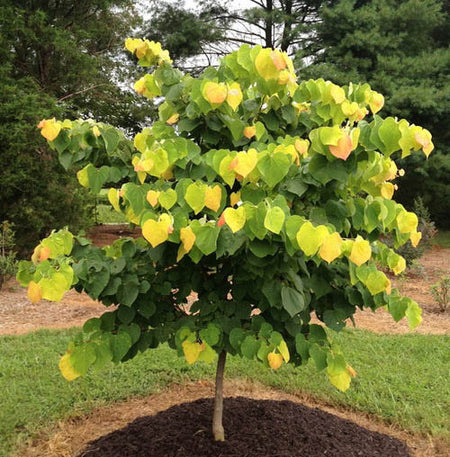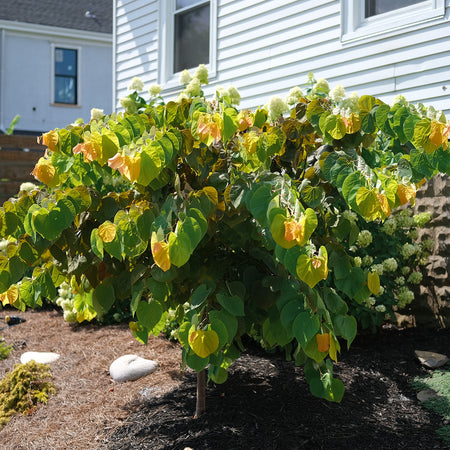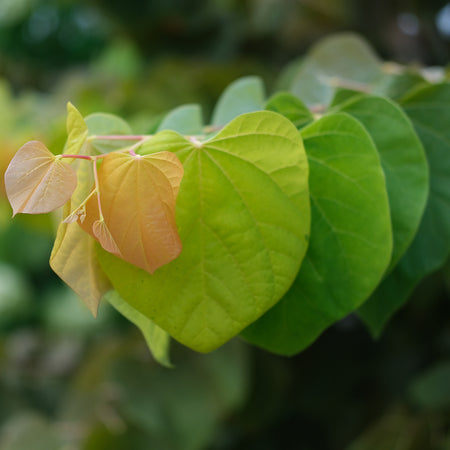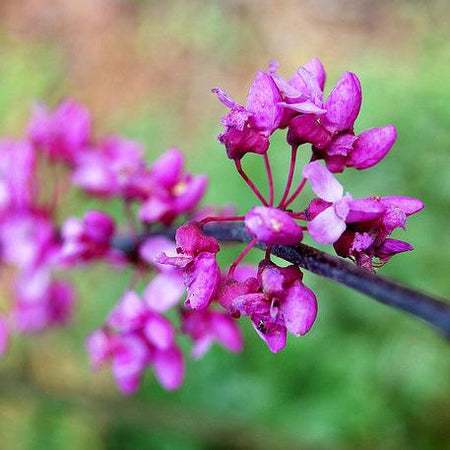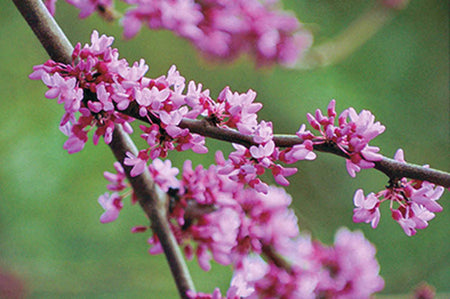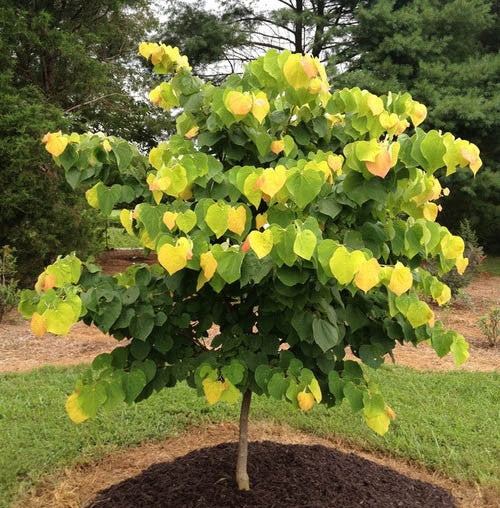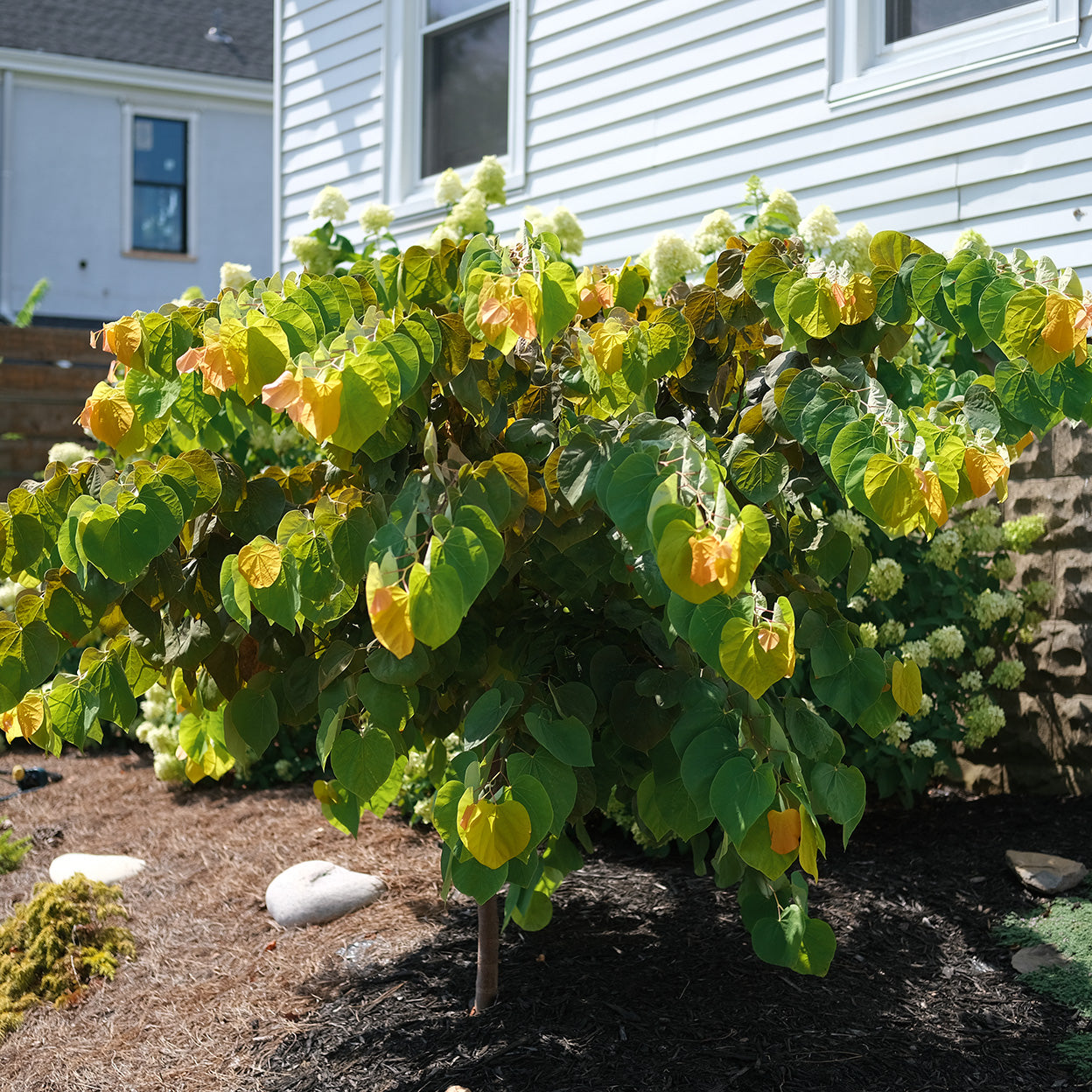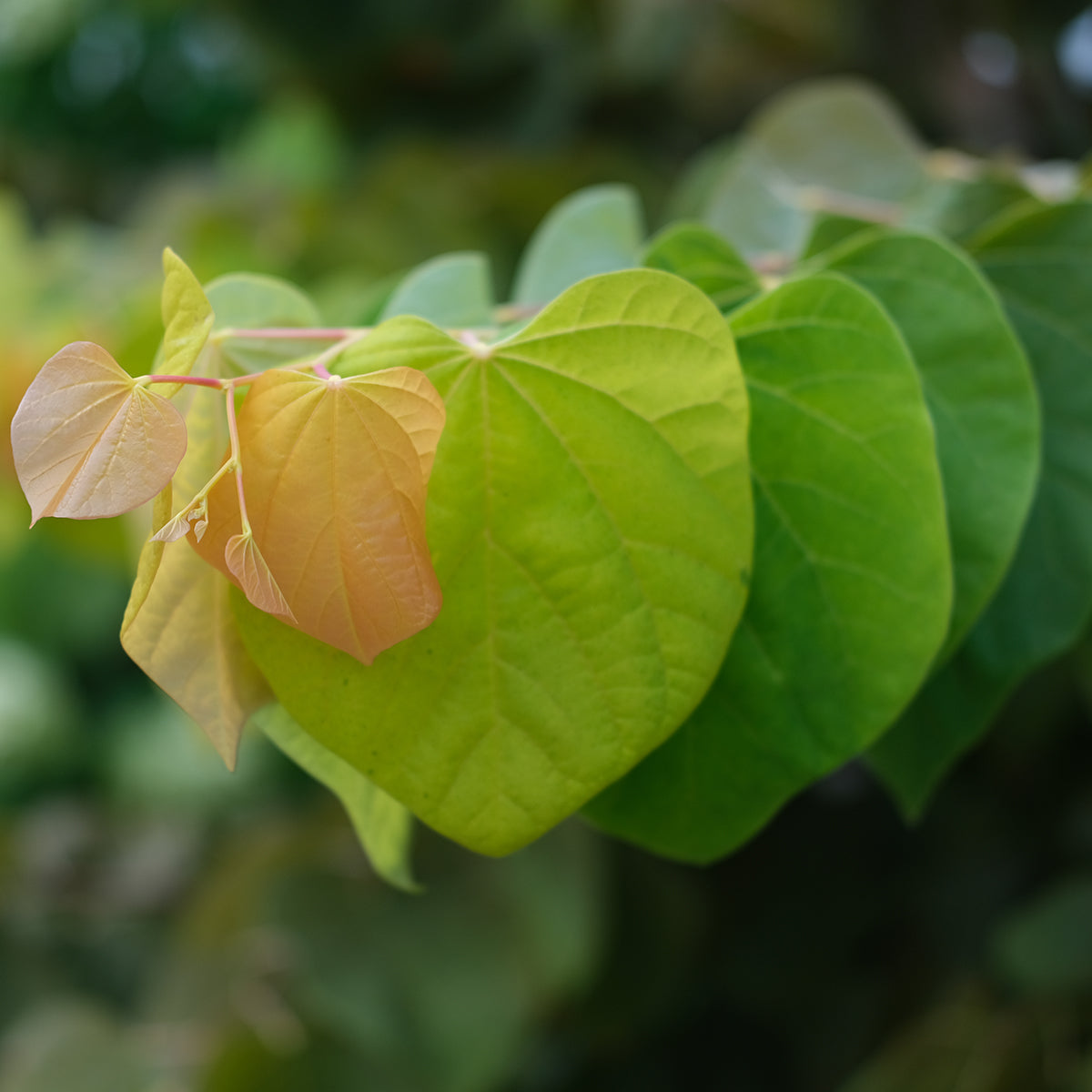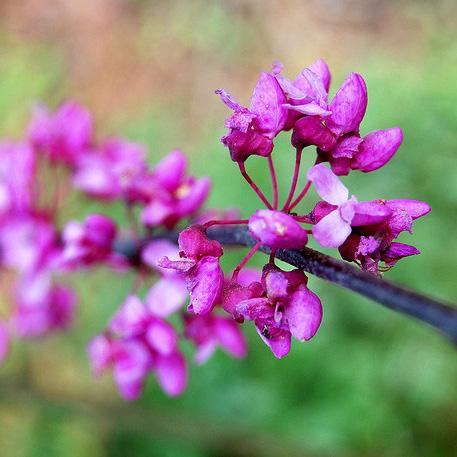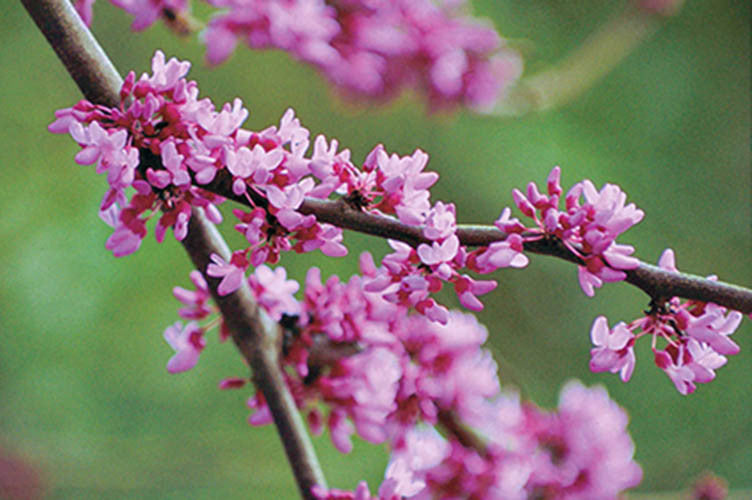Rising Sun™ Redbud
Cercis canadensis The Rising Sun (‘JNJ’)
Mature Height: 10 to 12 ft.
Mature Spread: 10 ft.
Couldn't load pickup availability
Shipping
The leaves are the most amazing feature of the Rising Sun™ Redbud. From spring to fall this tree will add eye-popping multi-color foliage to your home or garden. Starting at the trunk of the tree and moving outward the leaves of this tree transition from dark green, to pale green, to yellow, to bronze orange. This cascade of color provides captivating depth to the already gorgeous heart-shaped redbud leaves. It will also produce the classic redbud flowers of purple, pink that cluster along the branches in early spring.
Rising sun was discovered by one of Ray and Cindy Jackson of Jackson Nursery, who also discovered the Ragin' Red Dogwood and Blue Ray Kousa, in 2006. Since then it has become one of the most popular landscape trees in North America thanks to it's excellent coloration and resistance to drought, heat and sun scorch.
Over the last couple years we've been experimenting with Rising Sun. We have some in the yard and at the nursery. The small stature allows it to be useful in both border gardens/flower beds and also as a specimen planting on it's own. We find that planting them in bunches of three makes for a stunning flower bed that can be accented deep-green hostas, perennials, grasses or ferns depending on the lighting situation. Since the foliage on the rising sun features many colors we suggest pairing with non-variegated deep greens, purples or pinks along with hardscaping and a dark color mulch to provide a consistent base and let the Rising Sun shine. The Rising Sun is a native cultivar, and pairs well with other native perennials when the goal is a native North American garden.
In our experience we find that Rising Sun does well in both full sun and partial sun. Too much shade can reduce the range of color, so make sure you are getting at least 6 hours of sunlight when you plant to ensure the best appearance. Proper fertilization is also important. The more new growth on the tree the more color you will see - you can find more information about how to plant and fertilize on the tab labeled "Care" below.
| Bloom Color: | Purple |
| Bloom Period: | Early spring |
| Fall Color: | Yellow, with shades of green and orange |
| Foliage Color: | New growth emerges orange and transitions from yellow to green |
| Genus & Species: | Cercis canadensis The Rising Sun (‘JNJ’) |
| Growth Rate: | Moderate |
| Mature Height: | 10 to 12 ft. |
| Mature Spread: | 10 ft. |
| Soil Type: | Adaptable to many soil types, including wet soil, but prefers moist, but well draining soil that is rich in organic matter |
| Sun Exposure: | Full sun, partial sun, partial shade |
| Zone: | 5 to 9 |
General care for any tree or shrub is easy, but like any living thing will require your attention. Please educate yourself and follow these simple rules.
Redbud Trees
Redbuds are an amazing and varied species of tree. General care and soil requirements are the same, although light and temperature requirements will differ based on cultivar. We sell our redbuds bare-root, we've sold thousands of redbuds this way with few problems, but they will be lightly rooted when you get them. This means your number one priority should be getting the roots established. Do this by planting early in the spring (or fall if you are zone 7a or south) and caring for the tree appropriately with slow release fertilizer and proper water (a moisture meter works wonders).
Most problems with redbuds come from poor site selection. Tougher than a dogwood, a redbud is a hardy tree with few problems when sited properly. It will tolerate full sun or shade can withstand a bit of drought, but will struggle with disease and lack of growth in poor soil.
Site Selection
Redbuds do prefer some shade, afternoon shade is best as morning sun decreases problems with powdery mildew, but most cultivars will grow in full sun without issue. They will not tolerate a site with standing water and prefer well-drained soil rich in organic matter. Soil composition is less important with redbuds than compaction, which happens from heavy equipment, vehicle traffic, mower traffic or even lots of foot traffic. Compacted soil is hard and lacks the natural sponge like structure that redbuds need to grow. A good rule of thumb is that if grass is struggling in an area then redbuds will too. Speaking of grass, grass should be removed in a 2-3 ft. radius around the redbud. Wood mulch should be applied and must be applied to qualify for a refund. Rock leads to extra heating and is as likely to damage your tree as protect it. Finally, redbuds can grow in costal areas, but the salts near the ocean will cause growth issues. They should not be grown south of the Florida pan handle unless your micro-climate specifically sustains existing populations of the tree.
Powdery Mildew
Problems with powdery mildew can occur and if they do we recommend increased airflow and making sure your watering regiment does not wet the leaves. In very wet years or climates this problem can be unavoidable, but try pruning back some of the branches or your redbud to increase airflow. Early spring and after flowering are both suitable times to prune - following directions for proper tree pruning.
Redbud Leaf Roller Caterpillars
Leaf roller caterpillars are small and zebra striped. They will fold, roll, or paste leaves together with silk to create a home. Once again established trees should not be a problem (see below for weeping redbuds), pruning back some of the leaves can improve airflow and access to predators. If you continue to be bothered by them, we suggest stepping back 10 ft. and seeing if they are still a problem. If they are, we prefer the long term solution of creating habitat for predators, birds and tiny parasitic wasps (they don't sting) over the use of pesticides that do more harm than good. Once again eliminating some of the leaf density will give them less high quality real estate, while making them easier for predators to reach. Peeling apart stuck leaves before they receive too much damage is also helpful. We don’t recommend pesticides as these will struggle to reach the leaf rollers caterpillars, simply making them more accessible to predators and using the 10 ft. rule (view the trees from 10 feet away) are the best approaches to dealing with this important food source for birds.
Leaf Cutter Bees
We get a lot of questions about perfectly cut circles and semicircles in redbuds. These are fascinating in their own right, and you may think tiny ancient aliens visited your tree at night. This is the work of the leaf-cutter bee, which is an important native pollinator that uses redbud leaves to make its nests. Once again, living with nature and the 10 ft. rule is the best approach here.
Weeping Redbuds
Weeping redbuds are great trees for small spaces, use them in a home landscape for their unique appearance and beautiful qualities. They must be trained to a certain height, so if purchased below the intended size, stake them and tie them with vinyl tape periodically to help them reach the desired size. At 3-4 in height they make an interesting alternative to shrubs, at 6-7 feet they are gorgeous weeping trees.
Powdery mildew and redbud leaf rollers can be a bigger problem for weeping redbuds due to the leaves layering on top of one another that create a lack of airflow and deny access to predators. We recommend periodic pruning of your weeping redbud if you experience either of these issues. Think of it as a haircut and take your time pruning only a small amount and smaller branches if possible. Spring and summer after flowering are both good times to prune.
Rising Sun™ Redbud
Soil quality and how to plant the Rising Sun Redbud
The Rising Sun, like most redbud trees prefers consistently moist soil that is rich in organic matter, but can do well in a wide range of soils. Soil compaction will restrict growth and should be addressed by digging as large a hole as possible. We recommend a minimum of 3x3 ft. and digging at least 18 inches deep to break up the soil. Remove the grass, but retain as much of the original soil from the grass clumps as possible. A higher quality soil can be supplemented, but use no more than a 30% new to 70% original soil ratio. Too much new soil can cause water to pool in the hole, which will drown and kill the plant. With redbuds, mulching is extremely important (especially in the early years) as it suppresses grass and weeds, retains moisture, improves soil quality and reduces the chances of compaction from foot or mower traffic. For more specific details on how to plant see our guide.
When to fertilize the Rising Sun RedbudThe Rising Sun depends on new growth for it to maintain it's spectacular appearance, so fertilizer is recommended for optimal growth. A soil test is recommend for accurate fertilization, but a general NPK + micronutrients slow release fertilizer will cover the basis if a test is not performed. We recommend a 10-11 month slow release fertilizer be applied each year as a top dress in the mulch around the growing area. Apply this fertilizer prior to spring, so that the tree has access to nutrients in the spring and fall growing periods.
How and when to prune the Rising Sun RedbudPruning can be a challenge for new gardeners, so unless you are experienced, we recommend limiting pruning to a few branches each season. Pruning can be done during the winter months, but will rob you of the newest blooms. Pruning can also be done in late spring, after the blooms fade. Try to focus on branches that cross into the tree or create a steep V as these can create rubs, restrain growth on the central leader, and lead to breakage. Prune branches that are lower to the the ground to allow for space under the tree for mowing and and a more tree-like appearance. Most redbuds will grow shoots around the base of the tree, trim these back as low to the ground as possible each season. I've seen shoots grow almost to the size of a small tree within a few months, so get them as early as you can. When pruning take care to prune branches when they are as small as possible and take no more than 1/3 of the branches from a tree in one season.

